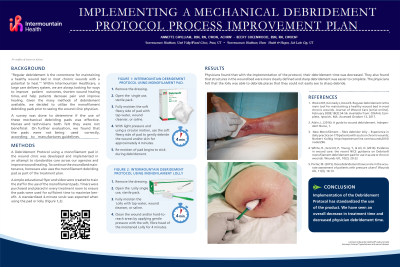Evidence-Based Practice
(EBP-006) Implementing A Mechanical Debridement Protocol Process Improvement Plan

Regular debridement is the cornerstone for maintaining a healthy wound bed in most chronic wounds with a potential to heal. Within Intermountain Healthcare, a large care delivery system, we are always looking for ways to improve patient outcomes, shorten wound healing times, and help patients decrease pain and improve healing.
Methods:
A Debridement Protocol using a monofilament pad in the wound clinic was developed and implemented in an attempt to standardize care across our agencies and improve wound healing. To continue the wound bed maintenance, homecare also uses the monofilament debriding pad as part of the treatment plan.
Results: Physicians found that with the implementation of the protocol, their debridement time was decreased. They also found
that structures in the wound bed were more clearly defined and sharp debridement was easier to complete. The physicians
felt that the lolly was able to debride places that they could not easily see to sharp debride.
Discussion: Developing a protocol to incorporate a monofilament device to debridement procedures, and or wound bed preparations will help clinicians decrease time, and pain while also providing better patient outcomes.
Trademarked Items:
References: 1. Wolcott R, Kennedy J, Dowd S. Regular debridement is the
main tool for maintaining a healthy wound bed in most
chronic wounds. Journal of Wound Care [serial online].
February 2009;18(2):54-56. Available from: CINAHL Complete,
Ipswich, MA. Accessed October 13, 2017.
2. Atkin, L. (2016). A guide to wound debridement. Independent
Nurse, 1.
3. New Monofiliment – fibre debrider lolly – Experience in
daily practice on 170 patients with acute or chronic wounds;
Norbert Kolbig https://epostersonline.com/wounds2016/
node/296.
4. White, R., Grocott, P., Young, T., & Ali, O. (2014). Evidence
in wound care: the recent NICE guidance on Debrisoft
monofilament debridement pad for use in acute or chronic
wounds. Wounds UK, 10(2), 20-22
5. Porter, M. (2015).Doesdebridement have a role in the accurate
assessment of patients with pressure ulcers? Wounds
UK, 11(3), 10-13.

.png)
